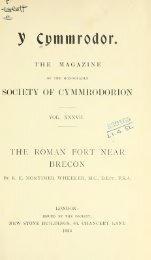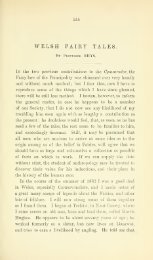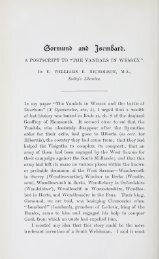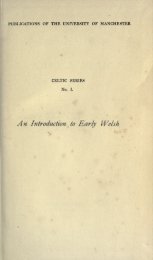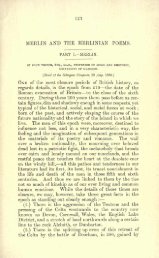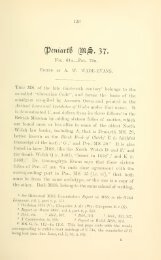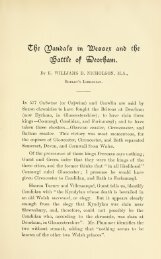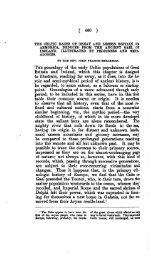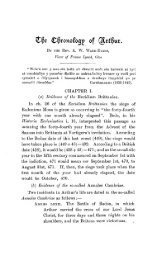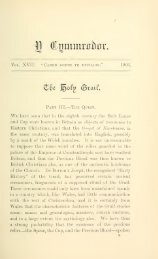Pen y Gaer and Caractacus (vol 34) - Arthur Pendragon of Wales
Pen y Gaer and Caractacus (vol 34) - Arthur Pendragon of Wales
Pen y Gaer and Caractacus (vol 34) - Arthur Pendragon of Wales
You also want an ePaper? Increase the reach of your titles
YUMPU automatically turns print PDFs into web optimized ePapers that Google loves.
THE<br />
JOURNAL<br />
Biittsl) ^rdjatolocjical aissociation.<br />
JUNE 1878,<br />
PEN-Y-GAER, CHIEFLY IN CONNECTION WITH<br />
CARACTACUS, AND OTHER BRITISH<br />
REMAINS IN NORTH WALES.<br />
BY T. F. DILLON CROKER, ESQ., F.S.A.<br />
Since our Confess this year is held in the famous Vale <strong>of</strong><br />
Llangollen, I have been desirous to select a subject for a<br />
short paper on some point <strong>of</strong> interest connected with North<br />
<strong>Wales</strong>, <strong>and</strong> it has occurred to me that something might be<br />
said in reference to <strong>Pen</strong>-y-<strong>Gaer</strong> (" the summit <strong>of</strong> the fort"),<br />
near Cerrig-y-Druidion {" the stones <strong>of</strong> the brave"), about<br />
twenty miles from this spot.<br />
When passing the remains in question, the mind naturally<br />
reverts to the stirring incidents relating to the conquest<br />
<strong>of</strong> <strong>Caractacus</strong> (or Caradoc) by the Romans, <strong>and</strong> the<br />
betrayal <strong>of</strong> that brave old British king by Cartism<strong>and</strong>ua.<br />
I regret to say that about the actual ruin _^;er se, I find the<br />
facts to be gathered are, like the ruin itself, not considerable.<br />
The most important reference that I have found<br />
occurs in a little <strong>vol</strong>ume entitled Remarks iqjon North<br />
<strong>Wales</strong>, being tlw Result <strong>of</strong> Sixteen Tours throiujli tliat part<br />
<strong>of</strong> the Principality, by W. Hutton, F.A,S,S. (Birmingham,<br />
1803). The writer thus describes these remains: "Upon<br />
the first hill east <strong>of</strong> the village <strong>of</strong> Cerrig-y-Druidion, <strong>and</strong><br />
distant one mile, is <strong>Pen</strong> Gwcryn, where the antiquary will<br />
be pleased with the small remains <strong>of</strong> a castle belonging to<br />
the celebrated <strong>Caractacus</strong>. As the traveller approaches the<br />
top <strong>of</strong> the hill, which is <strong>of</strong> easy ascent, he first comes to a<br />
trench about 36 feet wide. A small part <strong>of</strong> the soil having<br />
1878 18
140 PEN-Y-GAER AND OTBER BRITISH<br />
been tlirown up on the outside, constitutes a mound 3 feet<br />
high ; but the greater part being discharged on the inner<br />
side, forms a rampart about 15 feet from the bottom <strong>of</strong> the<br />
trench. This rampart encircles the upper part <strong>of</strong> the hill,<br />
rather <strong>of</strong> an oval form; is everywhere visible, in some places<br />
nearly perfect, <strong>and</strong> encloses six or seven acres.<br />
"Ascending 60 or 70 feet more, he next meets with the<br />
foundation <strong>of</strong> the wall, about 6 feet thick, which forms the<br />
upper area, running regular with the trench below, <strong>and</strong><br />
enclosing four or five acres. From the thickness <strong>of</strong> the<br />
wall, now level with the ground, we may reasonably conclude<br />
it ran 12 or 14 feet high. As one part <strong>of</strong> the area is<br />
higher than the other, it points out the exact spot where<br />
the castle stood, nothing <strong>of</strong> which remains. The whole is a<br />
pasture. The situation is on a considerable hill, but not a<br />
mountain. The prospects are extensive, but barren, <strong>and</strong> its<br />
affinity to Ccrrig-y-Druidion proves that the Prince <strong>and</strong> the<br />
priests were upon friendly terms.''<br />
I have been unable to discover any reference to the<br />
British King by any British historian <strong>of</strong> the period, excepting<br />
a comparatively unimportant allusion to him in the<br />
Triads ; therefore I trust I may be pardoned should I fly<br />
<strong>of</strong>f somewhat from the subject, <strong>and</strong> refer rather more to the<br />
events in connection with the fortress than to the fortress<br />
itself ; <strong>and</strong> further, that I may be allowed to shelter myself<br />
by one or two brief quotations.<br />
In the year 47 we find the south-eastern part <strong>of</strong> Britain<br />
had been subjugated by the Roman invaders; but the Ordovices<br />
<strong>and</strong> Silures, inhabitants <strong>of</strong> North <strong>and</strong> South <strong>Wales</strong>,<br />
always famous for their bravery (witness their gallant bearing<br />
at Alma in our own time), still held Cambria ; <strong>and</strong><br />
although, as I have stated, the Komans were the possessors<br />
<strong>of</strong> a great portion <strong>of</strong> Britain, the Roman power under the<br />
Emperor Claudius was not shining with the same brilliancy<br />
as formerly. Hume tells us that " the other Britons, under<br />
the comm<strong>and</strong> <strong>of</strong> <strong>Caractacus</strong> or Caradog, still maintained an<br />
obstinate resistance, <strong>and</strong> the Romans made little progress<br />
against them till Ostorius Scapula w^as sent over to comm<strong>and</strong><br />
the Roman armies. Under this comm<strong>and</strong>er Roman<br />
camps were established on the Avon <strong>and</strong> Severn ; the Iceni<br />
were reduced after a desperate <strong>and</strong> brilliant struggle, <strong>and</strong><br />
the league <strong>of</strong> the Brigantes were surprised <strong>and</strong> dispersed by
REMAINS IN NORTH WALES. 141<br />
the rcipid march <strong>of</strong> Ostorius, <strong>and</strong> the Roman eagles pervaded<br />
the greater part <strong>of</strong> Britain. But the Silures <strong>and</strong><br />
Ordovices still held out."<br />
Upon referring to Williams' Cymry we are told that "In<br />
a convention <strong>of</strong> the country <strong>and</strong> neighbouring country,<br />
under all the limits <strong>of</strong> the nation <strong>of</strong> the Cymry, Caradog,<br />
the son <strong>of</strong> Bran, was invested with the martial sovereignty<br />
<strong>of</strong> all<br />
the Isle <strong>of</strong> Britain, that he might oppose the invasion<br />
<strong>of</strong> the Eomans. All the Britons, from king to vassal, enlisted<br />
under his banner, at the call <strong>of</strong> the country, against<br />
foe <strong>and</strong> depredation." After nine years' desperate fighting,<br />
<strong>Caractacus</strong> was compelled to retreat towards North <strong>Wales</strong>,<br />
the country <strong>of</strong> the Ordovices, when a decisive battle was<br />
fought, <strong>and</strong> <strong>Caractacus</strong> was defeated, although at the same<br />
time it must be fully understood that Cambria itself still<br />
remained in the h<strong>and</strong>s <strong>of</strong> the British. The exact spot <strong>of</strong><br />
this great battle has alwaj-s been a subject <strong>of</strong> controversy;<br />
<strong>and</strong> is likely to remain so, there being nothing to enable us<br />
to decide its precise position. Tacitus says in his Annals<br />
(No. xii), speaking <strong>of</strong> <strong>Caractacus</strong>, that " he posted himself<br />
on a spot to which the approaches were as advantageous to<br />
his own troops as they were perplexing to us. He then<br />
threw up, on the more accessible parts <strong>of</strong> the highest hills,<br />
a rampart <strong>of</strong> stones, below <strong>and</strong> in front <strong>of</strong> which was a river<br />
difficult to ford.<br />
ramparts."<br />
Picked men showed themselves before the<br />
However, the Roman arms prevailed, <strong>and</strong> <strong>Caractacus</strong>,<br />
after bravely defending his country for nine years,<br />
was compelled to fly.<br />
<strong>Pen</strong>-y-<strong>Gaer</strong> was at this time occupied by Cartism<strong>and</strong>ua,<br />
Queen <strong>of</strong> the Brigantes, the inhabitants <strong>of</strong> the country lying<br />
between the Huml)er <strong>and</strong> the Tyne. To <strong>Pen</strong>-y-<strong>Gaer</strong> <strong>Caractacus</strong><br />
fled, dem<strong>and</strong>ing sanctuary <strong>of</strong> his stepmother, the<br />
Queen, for himself <strong>and</strong> his family. Cartism<strong>and</strong>ua is said to<br />
have hated her stepson, <strong>and</strong> being anxious to ingratiate<br />
herself with the conquerors, she most treacherously ordered<br />
the royal fugitives to be put in chains, <strong>and</strong> she subsequently<br />
delivered them up to the Romans :<br />
" The cry is heard, the long, loud wail,<br />
O'er Hood <strong>and</strong> plain, o'er hill <strong>and</strong> dale :<br />
It is the heai-t <strong>of</strong> Cymru bleeds<br />
For fallen sons <strong>and</strong> treacherous deeds.<br />
Dismay dwells in Caradoc's halls<br />
;<br />
The royal minstrel doleful calls<br />
Forth from his harp a strain his own sad heart appals."
.<br />
142 PEN-Y-GAER AND OTHER BRITISH<br />
Had the brave but unfortunate British King not fled to<br />
<strong>Pen</strong>-y-<strong>Gaer</strong>, he might possibly have been ignominiously<br />
slain, <strong>and</strong> history would have lost one <strong>of</strong> her brightest<br />
pages. I allude to the memorable speech made by the<br />
prisoner before his conqueror, the Emperor Claudius, at<br />
Kome, <strong>and</strong> the magnanimous conduct <strong>of</strong> the latter. The full<br />
account <strong>of</strong> this will be found in Hoare's Giraldus, p. 105.<br />
AVith the true generosity <strong>of</strong> a great nature, Claudius immediately<br />
released <strong>Caractacus</strong> <strong>and</strong> all the members <strong>of</strong> his<br />
family, <strong>and</strong> thus added to his crown perhaps its<br />
brightest<br />
jewel, the quality <strong>of</strong> mercy. <strong>Caractacus</strong> is stated to have<br />
said, when viewing Rome, " Is it possible tliat the Eomans,<br />
who possess such splendid palaces at home, can envy me<br />
my humble cottage in Britain V<br />
" And then his thoughts would w<strong>and</strong>er back to those<br />
Old days when in Glamorgan, as a boy.<br />
He gazed upon the peaceful mountain herd.<br />
And never dream'd <strong>of</strong> bloody times to come,<br />
And treachery at Carlism<strong>and</strong>ua's h<strong>and</strong> ;<br />
Or when he watch'd, near prond Eryri's brow,<br />
Some liungry eagle circling round her prey,<br />
Ne'er saw foreshadowed in that airy flight<br />
The Roman eagles destined to swoop down<br />
Triumphant o'er the country <strong>of</strong> his birth,"<br />
These lines occur in a fragmentary poem entitled <strong>Caractacus</strong>.<br />
There is an amount <strong>of</strong> interest attached to the stay <strong>of</strong><br />
<strong>Caractacus</strong> in Rome, in connection with the history <strong>of</strong><br />
Christianity. <strong>Caractacus</strong> <strong>and</strong> his family were at Rome at<br />
the same time as St. Paul, <strong>and</strong> tradition asserts that two <strong>of</strong><br />
the relatives <strong>of</strong> the British King (a daughter <strong>and</strong> her husb<strong>and</strong>)<br />
were Christian converts, <strong>and</strong> that they are identified<br />
with the Claudia <strong>and</strong> Pudens mentioned in St. Paul's 2nd<br />
Epistle to Timothy, chapter iv, verse 2 1<br />
We are informed by the author <strong>of</strong> a most interesting<br />
w^ork entitled Welsh Sketches, chiejly Ecclesiastical (in the<br />
first Series), that " <strong>Caractacus</strong> had another daughter, Eurgain,<br />
who formed a college <strong>of</strong> twelve religious persons, called<br />
after her own name, ' Cor Eurgain. She was married to<br />
Sarllog, lord <strong>of</strong> Caer Sarllog, the present Old Sarum.'' It<br />
has been conjectured by some writers on the subject, that<br />
Bran, the father <strong>of</strong> <strong>Caractacus</strong>, was the first to introduce<br />
Christianity into this country.<br />
Claudia, previously referred to, must have possessed the
The<br />
REMAINS IN NOllTH WALES. 143<br />
proverbial beauty <strong>of</strong> the Welsh women <strong>of</strong> the present day,<br />
for we find the poet Martial Valerius addressing her in the<br />
following complimentary lines •}<br />
" Claudia coeruleis cum sit Rufina Britannis<br />
Edita, cur Latiae pectora plebis habet.<br />
Quale decus forma? ?<br />
Italides possunt, Attliides esse suam."-<br />
Romanam credere matrcs<br />
Such British remains as those I have alluded to are the<br />
only remnants we have in connection with many heroes <strong>and</strong><br />
incidents <strong>of</strong> the past. <strong>Wales</strong> is particularly rich in these<br />
remains, although many, so far as I have been able to discover,<br />
have received but little attention at the h<strong>and</strong>s <strong>of</strong> the<br />
archaeologist. Almost every mountain range in <strong>Wales</strong>, from<br />
Snowdon to Plinlimmon, contains some evidences <strong>of</strong> the<br />
British aborigines. It would occupy too much time to enlarge<br />
upon the subject on the present occasion ; but I would<br />
point, en passant, to Dinas Emrys, Dinas Ddinlle, Dinas<br />
Dinorthen, <strong>and</strong> the surrounding neighbourhood, Dinas Dinorwic,<br />
Dinas Mawr, <strong>and</strong> many others. Dinas Emrys, on a<br />
rock at the end <strong>of</strong> Llyn-y-Ddinas, it may be remembered,<br />
is said to have been the place to which Vortigern retired<br />
after he had trusted the " treacherous Saxons, <strong>and</strong> accepted<br />
the h<strong>and</strong> <strong>of</strong> Rowena". Mr. Timbs tells us that "the fatal<br />
feast had taken place on Salisbury Plain, <strong>and</strong> Hengist's<br />
awful words, Take your '<br />
swords', had been followed by the<br />
massacre <strong>of</strong> three hundred <strong>and</strong> sixty British nobles ;<br />
<strong>and</strong><br />
their imprudent, weak Prince, who had suffered himself to<br />
be lured by beauty, had been dragged captive to a dungeon<br />
till he yielded to all the dem<strong>and</strong>s <strong>of</strong> the victors. Sullen,<br />
but yet not quite subdued, Vortigern<br />
summoned to his aid<br />
all the sages <strong>of</strong> his kingdom, <strong>and</strong> by their advice commenced<br />
the construction <strong>of</strong> a fortress in Nant Gwynant,<br />
which was to secure him against attacks, <strong>and</strong> make him<br />
independent <strong>of</strong> his foes."<br />
And this subject wouM bring us to the incidents <strong>of</strong> the<br />
legend <strong>of</strong> the birth <strong>of</strong> JMerlin (or IMerddyn), etc. Indeed<br />
the remains <strong>of</strong> Dinas Emrys would form the subject <strong>of</strong> a<br />
most interesting paper. Dinas Ddinlle overlooks the sea,<br />
• Lib. i, Epiijram .'iS.<br />
2 Although born among the blue-eyed Britons, how fully has Claudia Rufiua<br />
the intelligence <strong>of</strong> the Roman people ! What beauty is hers ! matrons<br />
<strong>of</strong> Italy might take her for a KomaQ ] those <strong>of</strong> Attica for uu Athenian.
144 PEN-Y-GAER, ETC.<br />
<strong>and</strong> is said to have been connected with Segontium (Caernarfon)<br />
during the occupation <strong>of</strong> the Romans, although it<br />
bears evident traces <strong>of</strong> British origin, <strong>and</strong> has a double range<br />
<strong>of</strong> escarpments. Near Llyn Padarn are the remains <strong>of</strong><br />
Dinas Dinorwic <strong>and</strong> Dinas Mawr, <strong>and</strong> in the immediate<br />
neighbourhood are several highly interesting Druidic <strong>and</strong><br />
other ruins. A few miles on the road from Caernarfon to<br />
Pwllheli is the British fortress <strong>of</strong> Dinorthen, <strong>and</strong> many other<br />
British traces on the surrounding heights. There are the<br />
remains <strong>of</strong> an ancient British fort called Castell Corndochon,<br />
on the summit <strong>of</strong> a crag not far from Llanuwchllyn—respecting<br />
which no historical facts appear to be known, <strong>and</strong><br />
there is an eminence near Caer Gai where there has been a<br />
fort belonging to Cai Hir ap Cymyr, or, according to<br />
Spenser's Faerie Queen, Timon, the foster father <strong>of</strong> King<br />
<strong>Arthur</strong>. Several Roman coins have at various times been<br />
duo- up in the neighbourhood, but little more is known relative<br />
to Caer Gai, except that we read in Vaughan's sketch<br />
<strong>of</strong> the history <strong>of</strong> Merionethshire that a stone was found with<br />
the inscription, " Hie jacet Salvianus Bursocavi filius Cupetian."<br />
And so I might continue enlarging on the British<br />
remains in which this country is so rich, but I have merely<br />
mentioned the foregoing to show what a vast field <strong>of</strong> research<br />
may be explored by those anxious to push their<br />
archaeological inquiries.<br />
The remains at <strong>Pen</strong>-y-<strong>Gaer</strong> should, I consider, not be<br />
overlooked, since they are indisputably connected, as I have<br />
endeavoured to show, with the history <strong>of</strong> Britain, <strong>and</strong> I have<br />
no doubt that if<br />
they were to be investigated, many points<br />
<strong>of</strong> archseological interest might be discovered. They may<br />
be seen from the road near Cerrig-y-Druidion, st<strong>and</strong>ing on<br />
the brow <strong>of</strong> a hill to the east <strong>of</strong> the Holyhead road. Cerrigy-Druidion<br />
is a place in itself full <strong>of</strong> interest <strong>and</strong> antiquarian<br />
curiosities, <strong>and</strong> is referred to at some length by Camden.<br />
I have spoken <strong>of</strong> the site <strong>of</strong> Cartism<strong>and</strong>ua's fortress<br />
as <strong>Pen</strong>-y-<strong>Gaer</strong>, that being the name put down in the Ordnance<br />
Survey, but it is known in the neighbourhood as<br />
FeiKjwerwyn. It would be well could some <strong>of</strong> my archoeoloo-ical<br />
friends spare time to visit the spot, <strong>and</strong> investigate<br />
thoroughly a place which must always be <strong>of</strong> interest to the<br />
lovers <strong>of</strong> history <strong>and</strong> archaeology.




